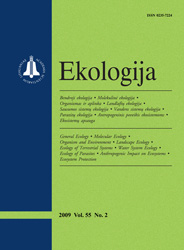 ISSN 0235-7224 ISSN 2029-0586 (online) |
2008 m. Nr. 2 The effect of ZeoVit sorptive features on nitrogen compounds, heavy metals and biological activity changes in sewage sludge
Problems of utilization of sewage sludge faced by cities, different industrial companies, agricultural farms are related to its agrochemical, chemical, toxic and organoleptic properties. Often the use of sludge as a fertilizer is impeded not by its chemical properties, but also by organoleptic properties, namely smell. The intensity of smells is related to the concentration of ammonia nitrogen in the sludge. Therefore, the objective of our work was to evaluate the influence of the natural sorbent ZeoVit on organic and mineral nitrogen forms, biological activity alterations in sewage and to study the concentration of heavy metals in the substratum. The research was carried out in field and laboratory conditions for the following variants: sludge mulched with zeolite mixed with the sorbent and mulched with the sorbent and only mixed with the sorbent. The amounts of common nitrogen in the sludge substratum decreased most significantly in the variant where the sorbent was mixed with sludge and also mulched. In this case, a stable tendency of the reduction of nitrogen concentration was established. However, it requires a large input of the sorbent (120–130 kg per ton of sludge). When sludge is only mixed with the sorbent (50 kg/t sludge), the level of nitrogen in the substratum decreases to 65.5% within 4 weeks. Zeolite is an effective measure for suspension of ammonia nitrogen emissions. The sorbent not only decreases emissions of ammonia nitrogen into the atmosphere, but also suspends a significant part thereof in the deep layers of sludge. At lower temperatures (close to 0 °C), the adsorption of common and ammonia nitrogen from the sludge processed with the sorbent is more dependent on the level of humidity and pH than in the summer season, because in the warm environment not only physical and chemical processes become more active, but also activity of pedobionts increases and strongly influences common and ammonia nitrogen adsorption alterations in the substratum. It was established that the superfluity of bacteria dissolving organic nitrogen and micromycetes remains at the level typical of sludge substratum, however, the sorbent slightly suppresses the hyperactive reproduction of bacteria dissolving organic nitrogen. Biotests and zoocenosis show that zeolite has no negative influence on the coprophagous biota of the soil. By mixing and mulching the sludge with zeolite, the strongest influence of it on reducing the concentration of heavy metals was obtained. Copper, chromium, nickel, cadmium are accumulated best, and lead is accumulated worst. To reduce emissions of ammonia nitrogen from the surface of sludge, the sludge should be mulched, and to increase the immobilization of ammonia nitrogen and heavy metals in the deep layer of sludge it would be purposeful to mix the sorbent with sludge. Keywords: sewage sludge, zeolite, nitrogen, heavy metals, microorganisms, pedobionts |
Issues:
2011 - Vol.57 No. 1, No. 2 2010 - Vol.56 No. 1-2, No. 3-4 2009 - Vol.55 No. 1, No. 2, No. 3-4 2008 - Vol.54 No. 1, No. 2, No. 3, No. 4 2007 - Vol.53 No. 1, No. 2, No. 2.priedas, No. 3, No. 4 2006 No. 1, No. 2, No. 3, No. 4 2005 No. 1, No. 2, No. 3, No. 4 2004 No. 1, No. 2, No. 3, No. 4 2003 No. 1, No. 2, No. 3, No. 4 2002 No. 1, No. 2, No. 3, No. 4 2001 No. 1, No. 2, No. 3, No. 4 |